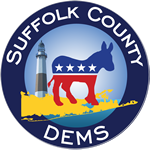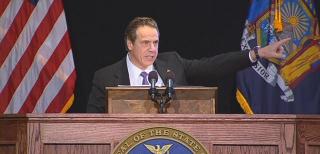A new plan to add a third track to the LIRR in Nassau County, from Floral Park to Hicksville, is among the proposals Gov. Andrew M. Cuomo announced Tuesday in an effort to boost the region’s economy.
Cuomo, in a speech to the Long Island Association business group, outlined a coordinated, and what he called a “holistic approach” to the Island’s infrastructure problems, most notably the long-delayed and controversial addition of a third track to the Long Island Rail Road’s Main Line in western and central Nassau.
The third track would encourage New York City residents to work on the Island because more track space would eliminate the bottleneck that now prevents additional eastbound trains during the morning rush hour, Cuomo said.
Cuomo said he would include the 9.8-mile third-track plan and other initiatives in his proposed 2016-17 state budget to be presented to the State Legislature on Jan. 13. The governor and lawmakers will have until the April 1 start of the fiscal year to agree on a spending plan, which could top $140 billion.
The governor also said he wants to:
Spend $5 million to study the feasibility of a tunnel across Long Island Sound to either the Bronx, Westchester County or Connecticut. The study would determine where the automobile tunnel would start.
Provide $6 million for a federal customs inspection facility at Long Island MacArthur Airport, allowing international flights to use the Ronkonkoma air terminal.
Hire a private company, AvPorts of Dulles, Virginia, to run Republic Airport in Farmingdale, which is owned by the state; and reserve 14.5 acres at the airport for aviation businesses and other commercial development.
Seek proposals from developers for a mixed-use project on 12.5 acres north of the airport, and reopen the shuttered LIRR station there.
Spend $1 million to study the feasibility of a deep-water port in Shoreham.
The proposals, if implemented, are intended to serve as a tonic for the Long Island economy, which has had steady but slow growth since the recession ended in 2009.
Local experts predicted last month that the Island’s economy would grow 2 percent to 2.5 percent in 2016, slightly faster than it did in 2015.
“We will see continuing growth, but it will be a little bit on the anemic side,” said Richard Vogel, dean of Farmingdale State College’s business school.
The LIRR third-track project would create 14,000 permanent jobs by 2035 and $3 billion in additional wages, according to a 2014 independent study commissioned by the Garden City-based Rauch Foundation’s Long Island Index.
Index officials said at the time, “by increasing regional mobility, third track would revitalize Long Island’s job market by attracting high-quality professional services and tech jobs, stem the outflow of young workers, generate new tax revenues, and encourage the provision of new transit-oriented housing that contributes to the revitalization of Long Island’s station areas.”
Cuomo’s proposal would replace earlier plans that have been disparaged by residents and local elected officials.
The governor said a key difference is that the entire third track would be built on the LIRR’s existing right of way, meaning fewer homes and businesses would be affected. Fifty properties, including 20 homes, would lose land, down from about 250 under previous proposals, he said.
Affected homeowners would be compensated for lost land, including the option of having their homes purchased by the state if they chose, Cuomo said.
For more than 30 years, the LIRR has considered building a passing lane of sorts on its congested Main Line, but planning began in earnest about a decade ago on the proposed $1.3 billion project.
However, residents from communities along the LIRR’s right of way turned out by the hundreds to oppose the project, which would have required the railroad to build on about 80 private properties.
In 2008, then-LIRR President Helena Williams announced the railroad was shelving a third track because of financial constraints. More recently, LIRR and MTA leaders have said they still believe in the importance of the third track but won’t move forward without the consensus of the communities involved.
Cuomo’s proposed budget would also revive a key project that for 50 years has been more dream than reality: a tunnel under Long Island Sound.
“The idea of having a direct connection to the mainland is very attractive,” Justin Meyers, a spokesman for Suffolk County Executive Steve Bellone, said in August. “Whether or not it’s economically feasible, environmentally feasible, and where it would go are still open questions.”
Suffolk is planning a separate tunnel study.
The $6 million funding request for the customs inspection facility at MacArthur Airport would provide the remaining dollars necessary to move that project off the drawing board.
Local officials and aviation experts have said the customs unit is crucial to the struggling airport’s viability after the loss of several domestic airlines.
Cuomo aides said Monday up to 400 international passengers could be screened every hour, and 1,200 jobs would be created at the airport and tourism-related businesses.

